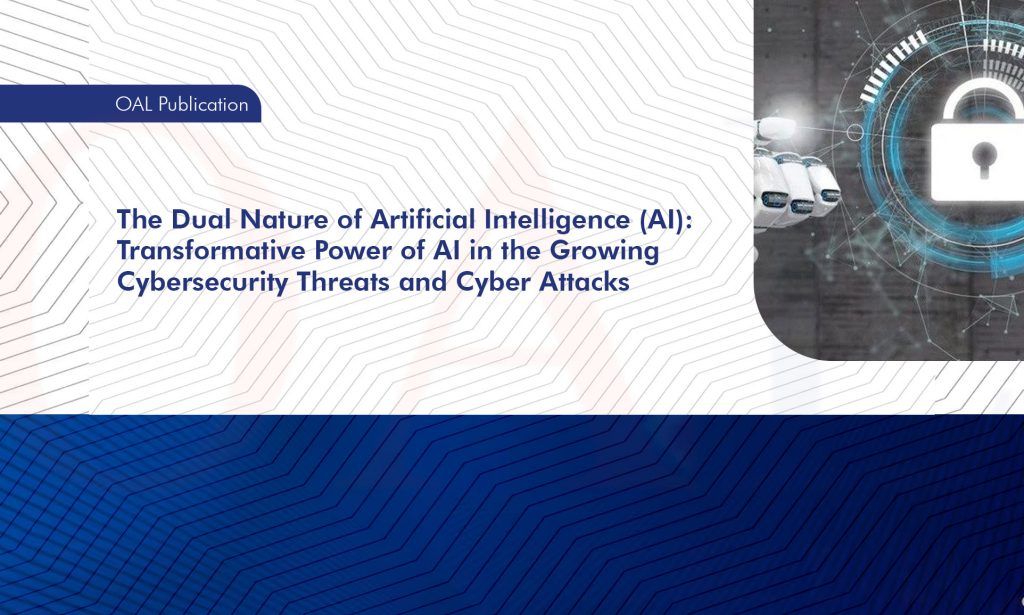
The Dual Nature of Artificial Intelligence (AI): Transformative Power of AI in the Growing Cybersecurity Threats and Cyber Attacks

Artificial Intelligence (AI) has ushered in a new era of possibilities, propelling innovation and reshaping various industries. However, with its increasing accessibility and sophistication, AI has also become a double-edged sword, presenting new threats and vulnerabilities to cybersecurity. This article explores the emergence of AI-related threats in the cybersecurity landscape, revealing the expansion of existing threats, the introduction of new ones, and the alteration of traditional attack characteristics. From manipulating public opinion to compromising critical infrastructure, malicious actors harness AI’s potential for nefarious purposes. As AI continues to evolve, proactive measures, international cooperation, and responsible AI research are essential to safeguard against these threats and ensure a secure digital future.
Artificial Intelligence (AI) Threats to Cybersecurity
The ever-evolving landscape of cybersecurity faces new challenges with the rise of Artificial Intelligence (AI). The internet’s decentralized nature has been a driving force behind its success, but as AI becomes more pervasive, it has the potential to change the internet as we know it. This article section will delve into the threats posed by AI to cybersecurity, backed by real cases, examples, and facts.
I. Manipulation of Information and Public Opinion
AI’s ability to manage the flow of information on the internet can be harnessed for nefarious purposes, including manipulating public opinion. Malicious actors can employ AI-powered bots to spread false information, creating a herd mentality and swaying public sentiment on critical issues. One real case that exemplifies this is the 2016 US Presidential election, where AI-driven bots on social media platforms were used to propagate misleading content and sow discord among voters. This incident shed light on the potential of AI to influence democratic processes and undermine trust in information sources.
A study conducted by researchers at Indiana University found that Twitter bots played a significant role in spreading misinformation during the 2016 US election.
II. Autonomous Creation of Malware and Cyber Attacks
AI’s capacity for autonomous decision-making enables it to develop sophisticated malware that evades traditional antivirus detection methods. Cybercriminals can use AI to constantly evolve their attack techniques, making it challenging for cybersecurity experts to keep up with rapidly changing threats. A well-known example is the Stuxnet worm, an AI-powered cyber weapon developed to sabotage Iran’s nuclear program in 2010. Stuxnet demonstrated the ability of AI to cause physical damage by manipulating industrial control systems.
The Stuxnet worm, discovered in 2010, targeted Iran’s nuclear facilities and caused substantial damage. It was highly sophisticated and utilized multiple zero-day vulnerabilities.
III. Fraudulent Social Media Profiles and Disinformation
AI can be employed to create deceptive social media profiles that appear genuine, making it challenging to distinguish between real and fake accounts. These fake profiles can then be used to spread false information and influence public opinions. The 2016 Cambridge Analytica scandal highlighted how AI-driven data analytics were used to target users with personalized disinformation campaigns, potentially impacting political outcomes.
The Cambridge Analytica scandal involved the collection and misuse of personal data from Facebook to influence political campaigns.
IV. AI in Military and Intelligence Applications
The military and intelligence communities leverage AI to identify specific items in videos and photographs, aiding in threat detection and analysis. However, the same technology can be weaponized by malicious actors to conduct reconnaissance and identify potential targets with alarming precision.
The use of AI-powered drones and surveillance systems by militaries worldwide demonstrates the application of AI in intelligence gathering and target identification.
V. AI in Financial Markets and Stock Market Crashes
AI’s ability to analyze vast amounts of financial data at high speeds has led to its extensive use in financial markets. Most of the forex trading is now conducted by AI systems rather than human traders. While AI can facilitate more efficient market operations, it also poses risks of stock market crashes if algorithms fail to anticipate unforeseen events.
A study in 2019 indicated that over 92% of forex trading was done by AI. The “Flash Crash” of 2010 saw the Dow Jones Industrial Average plunge nearly 1000 points in minutes, partly attributed to algorithmic trading errors.
VI. Distinct Cybersecurity Challenges and Vulnerabilities
AI attacks differ from traditional cyber-hacking exploits. Unlike conventional software, machine learning vulnerabilities are not always patchable, leading to persistent gaps for attackers to exploit. Some AI vulnerabilities can be exploited without direct access to the target system or network, making detection and defense more challenging.
Researchers from Google’s AI research lab, DeepMind, demonstrated that adversarial attacks on machine learning models could cause misclassification with high success rates, even in black-box scenarios.
Therefore, the emergence of AI brings both promise and peril to cybersecurity. While AI can bolster defense mechanisms, it simultaneously opens the door to new and complex threats that require innovative solutions. As the AI landscape continues to evolve, it is imperative for governments, industries, and cybersecurity experts to collaborate and devise robust strategies to safeguard against the threats posed by AI.
In terms of these transformations, academics believe that AI influences the cybersecurity landscape by:
- Expanding existing threats
- Introducing new threats
- Altering the typical characteristics of threats
I. AI’s Expansion of Existing Threats
Artificial Intelligence (AI) has brought revolutionary advancements in various fields, but with its growing accessibility and sophistication, it has also unleashed a new wave of threats and challenges. In this article, we will explore the expansion of existing threats due to the democratization of AI. As AI becomes more readily available and affordable, malevolent actors are leveraging its power to carry out potentially serious attacks on vital infrastructure and beyond.
- Democratization of Artificial Intelligence
The democratization of AI refers to the increasing availability and accessibility of AI systems, tools, and knowledge to a broader range of individuals and organizations. This trend has enabled non-traditional actors to gain access to AI capabilities, blurring the lines between conventional and unconventional players in the threat landscape.
The availability of low-cost and highly effective AI systems has reduced the barriers to entry for malevolent actors. Previously restricted to well-funded organizations, AI-powered attacks are now within reach of a larger number of individuals and groups.
The democratization of AI is fueled by open-source AI tools and research. Software codes and AI-related research are readily accessible, leading to a proliferation of AI applications, including potentially malicious ones.
- Automation and Labor Disruption
The democratization of AI is transforming industries through automation, leading to disruptions in the job market. Simultaneously, this automation contributes to an expanding pool of malevolent actors who can leverage AI for harmful purposes.
The combination of cheap computing hardware, cloud-based computing capabilities, and open-source tools has facilitated the automation of AI attack creation. This convergence eliminates barriers to executing AI-driven
The ease of access to AI technology empowers various malicious actors to exploit vulnerabilities and conduct cyberattacks at scale. This expansion poses challenges for distinguishing and identifying the perpetrators of such attacks.
- AI-Enhanced Attacks and Exploits
The democratization of AI not only amplifies the frequency of cyberattacks but also enables attackers to create more sophisticated and harder-to-detect exploits, challenging cybersecurity measures.
AI systems trained on previous attack payloads can generate new, sophisticated payloads to exploit previously undiscovered system vulnerabilities. This increases the risk of novel system exposures.
AI-powered attacks can obfuscate the identity of the perpetrators, making it difficult to attribute attacks to specific actors. This anonymity provides malicious actors with an advantage and increases the potential for strategic warfare actions.
- Impact on National and International Security
The widespread availability of accessible AI solutions significantly impacts national and international security, with potential implications for lethal autonomous weapons systems (LAWS) and strategic warfare actions.
The dual-use nature of AI technology raises concerns about its potential application in the development and deployment of lethal autonomous weapons. Both state and non-state actors can exploit AI’s capabilities for strategic purposes.
AI’s democratization opens doors to delegate warfare actions to surrogates, reducing the direct involvement of human actors in armed conflicts. This raises ethical and accountability challenges in the use of AI in military contexts.
To summarize, the democratization of AI presents a double-edged sword—on one hand, it fosters innovation and accessibility, driving progress in various domains, while on the other hand, it expands the landscape of existing threats and poses significant challenges to security and global stability. As we embrace the potential of AI, it is crucial to strike a delicate balance between promoting innovation and mitigating the risks posed by malevolent actors. Effective oversight, responsible AI research, and international cooperation will be pivotal in navigating this complex terrain and ensuring a safer and more secure future for humanity.
II. AI’s Introduction of New Threats
Advances in artificial intelligence (AI) are transforming various industries and driving innovation, but they also come with a range of new threats that have the potential to disrupt societies and wreak havoc.
- Deepfakes: A New Era of Misinformation and Fraud
Deepfakes, a term coined in 2017, refer to the use of deep learning techniques to create synthetic media, including photos, videos, and texts, that appear convincingly real. The most critical tool behind deepfakes is the Generative Adversarial Network (GAN), which allows malicious actors to manipulate media content in deceptive ways.
Case Scenario: A CEO’s Voice Deepfaked to Commit Fraud
In March 2019, an AI-based deepfake was used to impersonate the voice of a CEO and demand a fraudulent transfer of €220,000 ($243,000). A UK-based energy company’s CEO believed he was following urgent orders from his boss, who he thought was the CEO of their parent company in Germany. The victim transferred the funds to a Hungarian supplier, only to find out later that the instructions came from a deepfake voice impersonating the CEO. Euler Hermes Group SA, the company’s insurance provider, confirmed the incident but did not disclose the names of the involved businesses (Brown 2019).
This case highlights the potential for deepfakes to facilitate financial fraud and manipulate high-stakes business decisions, which can lead to significant monetary losses.
Additional Threats Posed by Deepfakes
Besides financial fraud, deepfakes present other alarming risks:
- a) Sexual Misuse and Blackmail: Deepfakes can be employed to create non-consensual explicit content featuring individuals, leading to potential blackmail, personal harm, and abuse.
- b) Political Manipulation: Political figures’ deepfake videos can be spread across social media to sway public opinion and influence elections, leading to severe consequences for democratic processes.
- c) Scapegoating: In political contexts, deepfakes can be used as a scapegoat to discredit genuine evidence by falsely claiming manipulation, leading to a decline in trust in genuine information.
- AI-driven Password Guessing: Enhancing Cybercriminals’ Tactics
Cybercriminals are leveraging machine learning algorithms to improve their password-guessing tactics, which poses significant cybersecurity risks.
Case Scenario: Neural Networks Enhancing Password Guessing
Traditionally, password-guessing techniques like HashCat and John the Ripper relied on comparing password hashes to identify the corresponding password. However, with neural networks and generative adversarial networks (GANs), cybercriminals can analyze vast datasets of passwords and generate accurate password variants based on statistical patterns.
As a result, password-guessing attacks are becoming more sophisticated, targeted, and potentially more profitable for malicious actors.
- Impersonation of Humans on Social Networking Sites: Fooling Detection Systems
AI is also being used to mimic human behavior, enabling cybercriminals to deceive social media platforms’ bot detection systems.
Case Scenario: AI-Powered Impersonation on Spotify
Cybercriminals utilize AI to imitate human-like behavior on social media platforms, such as Spotify. They create malicious systems that generate fraudulent streams and traffic for artists. Such actions can lead to financial losses and disrupt the integrity of digital platforms.
Moreover, the emergence of robots capable of human communication raises questions about accountability and justice in cases where AI-driven entities commit crimes or engage in illegal activities.
- Data Poisoning: Turning AI Technologies Against Users
Hackers are employing data poisoning techniques to corrupt common AI technologies, including autocomplete, chatbots, and spam filters, and use them against users.
Case Scenario: Misleading Product Reviews and Fake News
Data poisoning attacks are simple to execute, and even novice hackers can exploit them to manipulate autocomplete, chatbots, and spam filters. This results in misleading product reviews, fake news dissemination, and potentially dangerous outcomes, especially when applied to online training or continuous-learning AI models.
- AI Attacks on Military Defence: A Growing Concern
With the increasing integration of AI in military systems, new vulnerabilities are being introduced, making them susceptible to AI-based attacks.
Case Scenario: AI’s Threat to Defence Systems
Military leaders are embracing AI to develop advanced defense systems, driven by sophisticated ML models. However, this reliance on AI also creates potential weaknesses that adversaries can exploit to compromise military security.
For example, adversaries could use AI to impersonate automated surveillance cameras, enabling them to move undetected in monitored areas. Additionally, AI could be used to subvert the navigation systems of autonomous vehicles, leading to disastrous consequences if used in civilian populations or infrastructure.
Case Scenario: Congress and Pentagon Initiatives for Deep-fake Detection
In response to the growing threat of deepfakes, the US Congress approved a $5 million initiative to support new deep-fake detection systems, demonstrating the Pentagon’s recognition of audiovisual manipulation as a critical national security threat.
Therefore, the introduction of AI brings immense potential for progress, but it also introduces new threats and risks that societies must confront. From deepfakes and password guessing attacks to data poisoning and AI-based military attacks, these threats demand proactive measures and innovative solutions. Governments, businesses, and individuals must collaborate to develop robust AI security protocols, implement advanced detection systems, and raise awareness about the potential dangers of AI misuse. Only through collective efforts can we harness the transformative power of AI while safeguarding against its harmful effects.
III. Altering the Typical Characteristics of Threats
The advent of Artificial Intelligence (AI) has undoubtedly revolutionized various aspects of our lives, from enhancing convenience to powering advanced technologies. However, with these advancements come a new set of challenges and vulnerabilities that have significant implications for cybersecurity. In this section, we will delve into the intricacies of AI-related threats, exploring how inherent vulnerabilities in AI systems are reshaping the landscape of cyberattacks and exposing our information technology infrastructure to novel risks.
- The Conventional Approach to Cyberattack Prevention
Traditionally, cybersecurity experts have relied on a well-established pattern of cyberattack prevention. This approach involves meticulously analyzing the lines of code in a particular software application to detect and rectify bugs, which are often caused by either intentional or accidental programming faults. For decades, this strategy has been the industry standard, effectively protecting software and systems against known vulnerabilities.
- AI Vulnerabilities: Adding a Layer of Complexity
AI systems, particularly those utilizing machine learning, present a new challenge in the realm of cybersecurity. Unlike traditional software, AI incorporates additional vulnerabilities that are not easily patched and result from the inherent nature of AI functioning and learning processes. These vulnerabilities create a complex and unpredictable threat landscape, making it difficult for conventional security measures to suffice.
- The Nuanced Approach of AI Attacks
Attacks against AI systems are not simply traditional cyberattacks with AI technology as the weapon; instead, they adopt a more sophisticated and nuanced approach. These attacks aim to gain control over the targeted system for specific purposes or manipulate the AI model’s behavior by revealing its inner workings. Four main types of attacks stand out in this context:
- Data Poisoning: In data poisoning attacks, malicious actors strategically introduce flawed data into the legitimate dataset used to train AI models. By doing so, they manipulate the AI’s behavior, causing it to make incorrect decisions or act maliciously in certain situations. This insidious attack vector challenges the reliability and integrity of AI systems, making them susceptible to adversarial manipulation.
- AI Model Reverse Engineering: This attack involves gaining unauthorized access to the AI model itself. Once attackers have access, they can identify vulnerabilities and craft more targeted and successful adversarial attacks. AI model reverse engineering allows cybercriminals to develop more effective means of exploiting AI systems, jeopardizing the security of sensitive data and operations.
- Tampering of Categorization Models: Attackers can compromise AI systems by tampering with the categorization models used to classify data. By manipulating these models, adversaries can successfully launch adversarial attacks, causing AI systems to misclassify or misinterpret inputs, which could have severe consequences, particularly in critical decision-making processes.
- Backdoors and Vulnerabilities: Cybercriminals can exploit vulnerabilities in AI systems by injecting backdoors. These backdoors serve as hidden entry points, allowing attackers to compromise the AI system once they are triggered. Such attacks not only compromise the confidentiality and integrity of data but also allow adversaries to gain unauthorized access and control over AI systems.
- Expanding the Arsenal: From Virtual to Physical Entities
What sets AI-related attacks apart from traditional cyberattacks is the expansion of the entities that can be exploited to carry out these attacks. While conventional cyberattacks primarily target software bugs or human errors in code, AI attacks transcend the virtual realm and involve physical objects as well. This development opens up new dimensions of vulnerability, wherein AI systems controlling critical physical infrastructure become potential targets for malicious actors.
Real-Life Examples and Evidence:
To illustrate the real-world impact of AI vulnerabilities and the growing sophistication of AI attacks, let’s examine some notable examples:
- Stuxnet Worm: The Stuxnet worm, discovered in 2010, was one of the first known instances of an AI-based cyberweapon. It targeted Iran’s nuclear facilities and utilized advanced AI techniques to propagate and target specific industrial control systems. This demonstrated how AI-based attacks could be used for strategic purposes and to compromise critical infrastructure.
- Deepfake Attacks: Deepfake technology, a product of AI, allows the creation of highly realistic and deceptive media content. Such content can be used to spread misinformation, manipulate public opinion, and even impersonate individuals in a way that’s difficult to detect. Deepfake attacks showcase the potential for AI-based threats to undermine trust in digital media and public figures.
- Autonomous Vehicle Manipulation: As AI technology powers the development of autonomous vehicles, there are concerns about potential attacks on these vehicles. Malicious actors could exploit AI vulnerabilities to gain control over autonomous vehicles, posing a severe risk to passenger safety and public transportation systems.
To summarize, the altering characteristics of AI threats have introduced a new era of cybersecurity challenges. Traditional approaches to cyberattack prevention no longer suffice, and organizations must adopt innovative and adaptive strategies to defend against the ever-evolving AI-based attacks. The integration of AI technology in critical infrastructure and daily life demands a comprehensive understanding of its vulnerabilities and the development of robust security measures to ensure a safer and more secure digital future. Only through continuous research, collaboration, and vigilance can we protect ourselves from the disruptive forces of AI-based threats.
Conclusion:
The integration of Artificial Intelligence into our lives has brought remarkable advancements, but it also poses unprecedented cybersecurity challenges. As AI democratizes, expanding access to its power, cyberattacks gain sophistication and target new vulnerabilities. Deepfakes, AI-driven password guessing, and manipulation of social media platforms are among the new threats introduced. Moreover, AI’s unique characteristics, such as data poisoning and model reverse engineering, demand novel approaches to cybersecurity defense. To confront these challenges effectively, collaboration between governments, industries, and cybersecurity experts is crucial. Responsible AI research, robust security protocols, and advanced detection systems will help strike the delicate balance between harnessing AI’s potential and safeguarding against its potential harm. Embracing innovation while being vigilant against AI-related threats will pave the way for a safer and more secure digital future.
AUTHOR:
Artificial Intelligence (AI) & Cybersecurity Writer
Contributor





